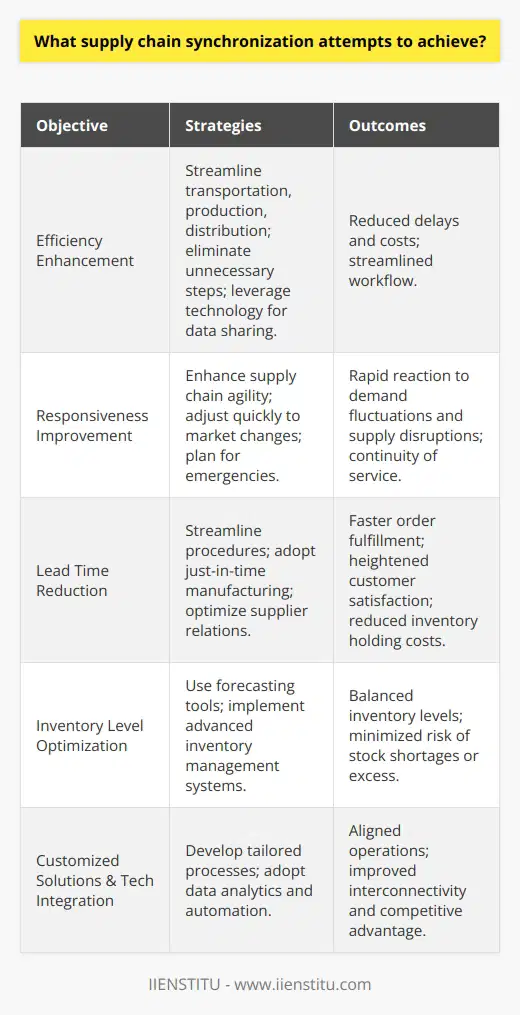
Synchronization of supply chain management requires the implementation of strategies that align the three critical functions of procurement, logistics, and operations. These strategies include the use of technology, the development of collaborative relationships between suppliers and customers, and the implementation of effective communication systems. Additionally, supply chain managers must ensure that the processes and activities involved in the management of the three functions are properly coordinated.
This article provides an overview of supply chain management (SCM), which is the coordination of activities involved in the procurement, production, and distribution of goods and services. It outlines the three critical functions of SCM - procurement, logistics, and operations - and explains the interdependence of these functions.
Finally, it discusses strategies for synchronizing supply chain management, such as using technology, developing collaborative relationships between suppliers and customers, and implementing effective communication systems.
Introduction
What is Supply Chain Management?
The Three Critical Functions of Supply Chain Management
The Interdependence of the Three Functions
Strategies for Synchronizing Supply Chain Management
Introduction: Supply chain management (SCM) is a critical element of any successful business. It is the process of managing the flow of goods and services from the point of origin to the point of consumption. It involves the coordination of various activities such as procurement, logistics, operations, and customer service. The goal of SCM is to ensure that the right products are delivered to the right customers, at the right time, and at the right price.
What is Supply Chain Management?
Supply chain management (SCM) is the coordination of all activities involved in the procurement, production, and distribution of goods and services. It involves the integration of all the processes and activities that are necessary to bring a product or service from its raw material state to the end customer. This includes the sourcing of raw materials, the production of the product or service, the storage and transportation of the product or service, and the delivery of the product or service to the customer.
The Three Critical Functions of Supply Chain Management
The three critical functions of supply chain management are procurement, logistics, and operations. Procurement involves the process of acquiring the necessary raw materials, components, and services in order to produce a product or service. Logistics involves the planning and coordination of the transportation and storage of goods and services from the point of origin to the point of consumption. Operations involve the production and distribution of the product or service.
The Interdependence of the Three Functions
The three critical functions of supply chain management are interdependent and must be managed in a coordinated manner. A successful supply chain requires an integrated approach to the management of these three functions. Poorly managed procurement, logistics, and operations can lead to delays, increased costs, and decreased customer satisfaction.
Strategies for Synchronizing Supply Chain Management
There are several strategies that can be used to synchronize the three critical functions of supply chain management. The first is to ensure that all departments are working together in order to achieve the desired outcomes. This includes the use of cross-functional teams and the implementation of integrated systems.
The second strategy is to ensure that the supply chain is properly aligned with the company’s overall strategy. This includes ensuring that the supply chain is aligned with the company’s goals and objectives and that it utilizes the most efficient and cost-effective methods of procurement, logistics, and operations.
The third strategy is to ensure that the supply chain is properly monitored and managed. This includes the use of data analytics to track and measure performance, the implementation of quality assurance protocols, and the use of predictive analytics to anticipate and address potential problems.
Conclusion: Supply chain management is a critical element of any successful business. It involves the coordination of the three critical functions of procurement, logistics, and operations. These functions are interdependent and must be managed in a coordinated manner in order to ensure the successful delivery of products and services to the customer.
There are several strategies that can be used to synchronize the three functions, such as cross-functional teams, integrated systems, and the use of data analytics. By implementing these strategies, companies can ensure that their supply chain is properly aligned with their overall strategy and that it is properly monitored and managed.
Synchronizing supply chain is the key to success; make it work and you will reap the rewards.
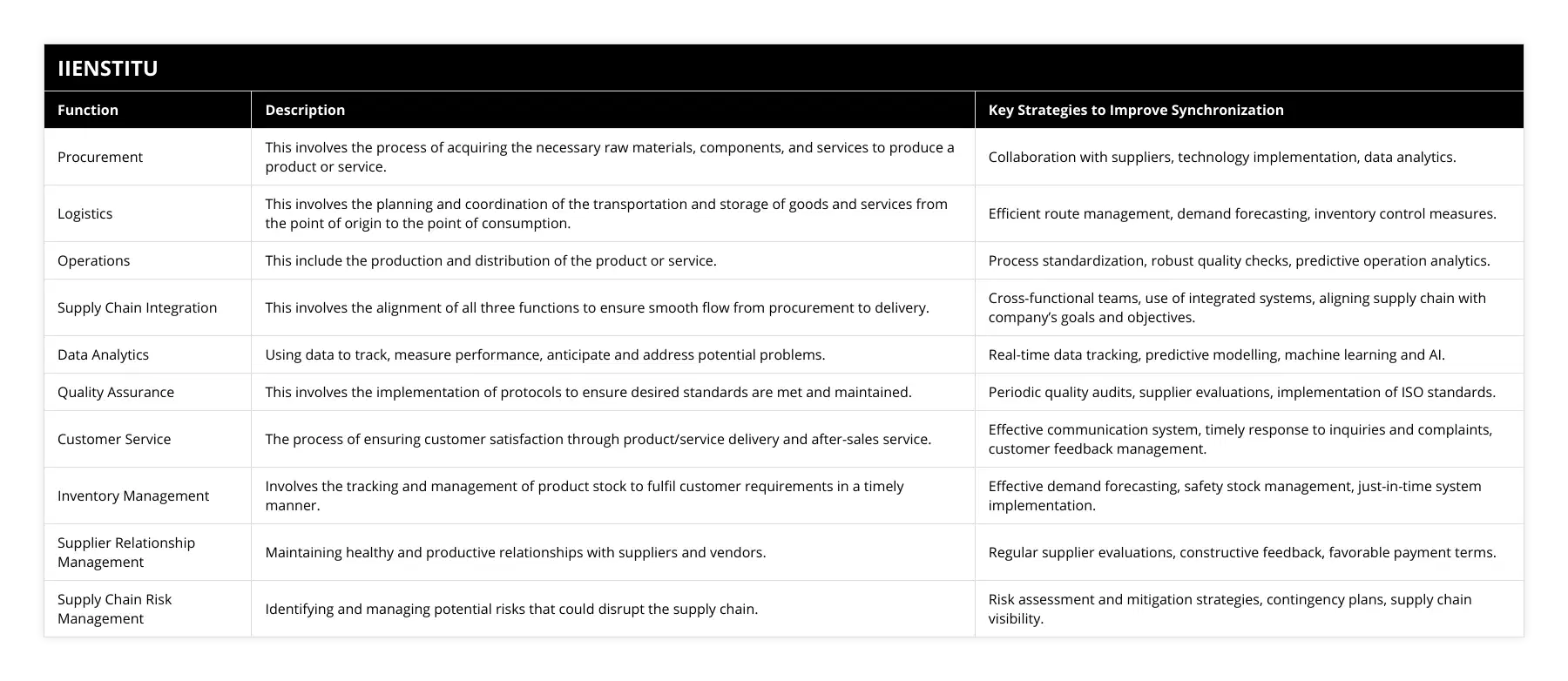
The text emphasizes the crucial role of supply chain management (SCM) in successful businesses, defining it as the strategic coordination of procurement, logistics, and operations. These three functions are people-dependent, requiring careful synchronization via cross-functioning teams, integrated systems, and the leverage of data analytics for optimization. Proper SCM alignment with overall company strategy, thorough monitoring, and effective management are essential for delivering the right products to the right customers at the right time. Garnering a deeper understanding of these techniques and earning a supply chain management certification online can aid businesses in improving their SCM, leading to reduced costs and increased customer satisfaction.
Frequently Asked Questions
What strategies can be used to synchronize supply chain management?
Strategies for synchronizing supply chain management include:
Utilizing technology to ensure consistency and accuracy of data and processes throughout the chain.
Establishing collaborative relationships between suppliers and customers to ensure seamless communication and coordination of activities.
Implementing effective communication systems to ensure that all stakeholders are aware of the current status of the supply chain.
Monitoring the processes and activities involved in procurement, logistics, and operations to ensure that they are properly coordinated.
Utilizing supply chain optimization techniques to reduce costs and improve efficiency.
Developing risk management strategies to address potential supply chain disruptions.

How does the interdependence of the three functions of supply chain management affect synchronization?
The interdependence of the three functions of supply chain management affects synchronization by requiring the implementation of strategies to ensure that the processes and activities involved in the management of the three functions are properly coordinated.
To ensure synchronization, supply chain managers must use technology, develop collaborative relationships between suppliers and customers, and implement effective communication systems. With proper synchronization, the efficiency and effectiveness of the supply chain can be improved, thus leading to improved performance and profitability.
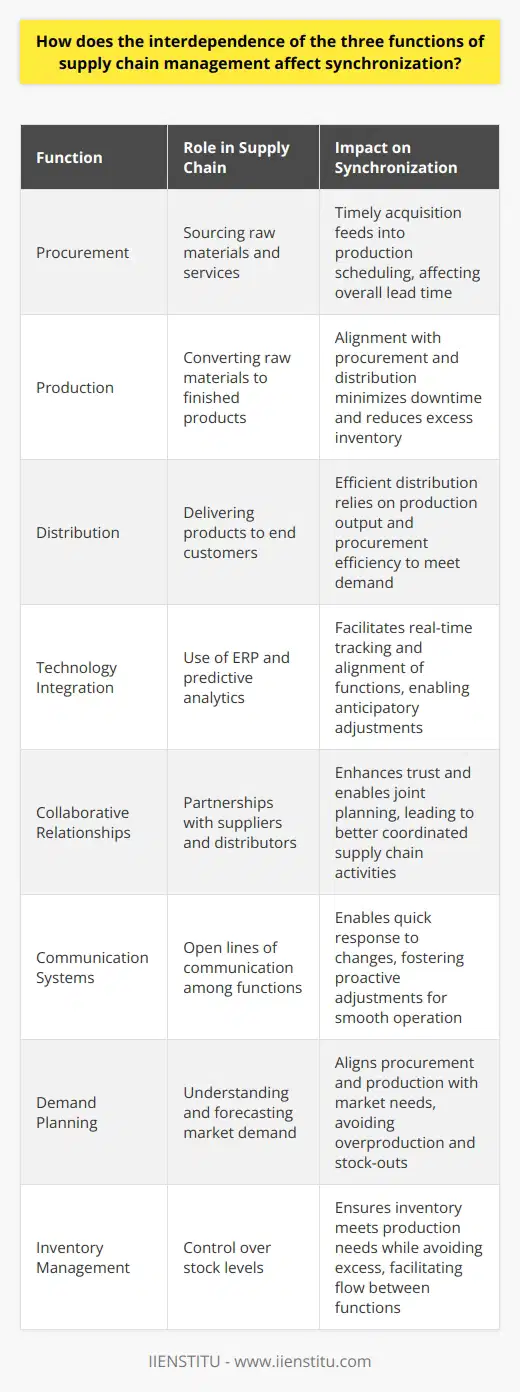
What are the benefits of synchronizing supply chain management?
The benefits of synchronizing supply chain management include improved efficiency, lower costs, improved customer service, increased inventory visibility, and improved communication with suppliers and customers. Synchronizing the three critical functions – procurement, logistics, and operations – allows for the smooth flow of goods and services from one point to the next, resulting in cost savings and improved customer service.
Additionally, improved visibility into inventory levels allows for more accurate planning and forecasting, which results in fewer delays and improved customer satisfaction. Finally, effective communication systems enable better communication between suppliers and customers, which leads to improved relationships and better collaboration.
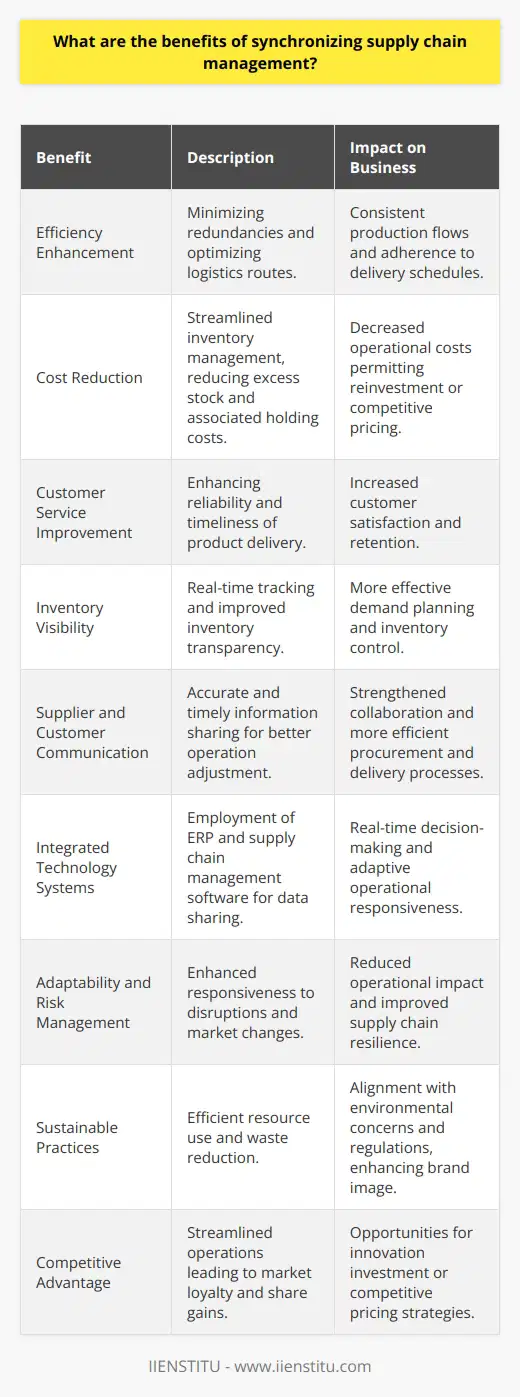
What are the key components for achieving effective supply chain synchronization?
Key Components for Effective Supply Chain Synchronization
Synchronized Planning and Execution
To achieve supply chain synchronization, one of the essential components is the synchronized planning and execution of activities across all levels. This includes integrating sales and operations planning, demand forecasting, production scheduling, and inventory management. Aligning these processes eliminates silos and enables companies to better anticipate demands, manage uncertainties, and optimize resources.
Information Sharing and Visibility
Supply chain partners must have access to real-time data and information to make informed decisions. The implementation of integrated IT systems, such as enterprise resource planning (ERP) and supply chain management (SCM) software, enables real-time data sharing and visibility throughout the supply chain. Such systems facilitate collaboration and communication, allowing stakeholders to identify issues, make adjustments, and prevent potential disruptions more efficiently and effectively.
Supplier and Customer Collaboration
Establishing close relationships with suppliers and customers while promoting collaboration through formalized agreements, such as vendor-managed inventory (VMI) programs, encourages the exchange of information and joint planning efforts. This collaboration enhances the efficiency of supply chain operations and strengthens the overall value chain.
Risk Management Practices
Effective supply chain synchronization also requires proactive risk management practices, including identifying potential risks, assessing their impact, and developing appropriate contingency plans. Companies should continuously monitor the performance of their supply chain, identify and address vulnerabilities, and ensure that adequate resources are available to respond to disruptions when they occur.
Agility and Flexibility
The ability to adapt to changing market conditions and evolving customer needs is an essential attribute of a synchronized supply chain. Companies must be agile and flexible in their supply chain operations, continuously seeking opportunities for improvement and innovation. Adopting lean management and continuous improvement techniques helps organizations streamline processes, increase efficiency, and remain competitive in a dynamic business environment.
In conclusion, effective supply chain synchronization requires an intricate balance of synchronized planning and execution, information sharing and visibility, collaboration with suppliers and customers, risk management practices, and agility and flexibility. Adopting these key components will optimize the overall supply chain performance, enhancing the organization's ability to respond to market changes and customer demands.

In the context of end-to-end supply chain management, how can organizations anticipate and mitigate potential disruptions?
Identifying Potential Disruptions
To anticipate and mitigate potential disruptions in end-to-end supply chain management, organizations must first identify the potential risks and vulnerabilities embedded in their supply chains. This process includes mapping the entire supply network and conducting thorough risk assessments of various elements such as suppliers, transportation, and external factors including geopolitical and environmental events.
Implementing Risk Management Strategies
Once potential disruptions are identified, organizations can implement robust risk management strategies. This involves developing contingency plans for various scenarios and incorporating flexibility into operations. For example, diversifying the supplier pool can help reduce the dependency on a single supplier, allowing a quicker response to unforeseen events.
Adopting Technology Solutions
Leveraging modern technology solutions such as artificial intelligence (AI), machine learning, and blockchain can enable organizations to streamline their supply chain management processes. These technologies can help in forecasting demand more accurately, improving visibility, and enhancing overall efficiency. Additionally, they can provide organizations with real-time data and predictive analytics, enabling them to make data-driven decisions that minimize the impact of disruptions.
Investing in Collaborative Relationships
Fostering strong and collaborative relationships with suppliers, customers, and logistics providers is crucial in mitigating potential disruptions. By sharing information and collaborating on risk management strategies, organizations can enhance their ability to respond to disruptions effectively. This collaboration can help build trust and improve the overall resilience of the supply chain.
Continuous Monitoring and Improvement
Organizations must regularly review and update their risk management strategies to adapt to the ever-changing global supply chain landscape. Continuous monitoring of supply chain performance can help organizations identify areas of concern and take proactive measures to address them. Additionally, conducting reviews after disruptions have occurred can provide valuable learnings and help organizations improve their mitigation strategies for future disruptions.
In conclusion, anticipating and mitigating potential disruptions in end-to-end supply chain management require a combination of proactive risk identification, implementation of risk management strategies, adoption of technology solutions, investment in collaborative relationships, and continuous monitoring and improvement. By embracing these measures, organizations can build resilient and agile supply chains that can withstand the challenges of an increasingly complex and uncertain business environment.
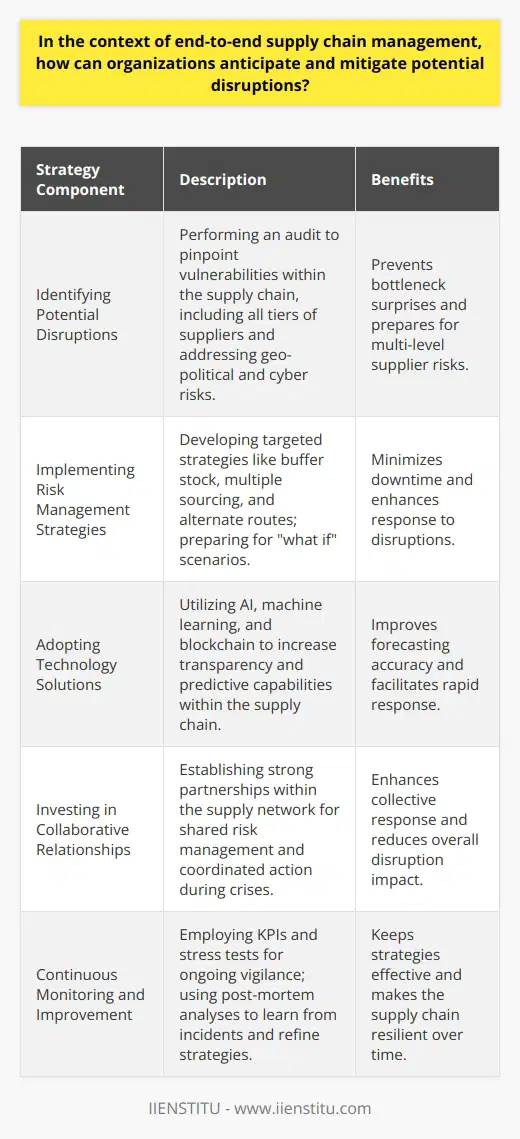
What role does technology play in enhancing supply chain synchronization and responsiveness?
Role of Technology in Synchronization
Technology plays a crucial role in enhancing the synchronization of supply chain operations by facilitating real-time communication between different stakeholders. Advanced information systems enable relevant parties to access and share information instantly, which leads to better decision-making, smoother workflow, and increased productivity.
Technology for Improved Responsiveness
In addition to synchronization, technology also contributes to improved responsiveness of the supply chain. Responsiveness in this context relates to the ability of a supply chain to adapt rapidly to changing circumstances, such as fluctuations in customer demand or unforeseen disruptions. Technologies like data analytics and artificial intelligence enable businesses to anticipate changes, forecast demand patterns, and optimize production schedules accordingly.
Technologies Enabling Synchronization and Responsiveness
There are several technologies that actively contribute to the enhancement of supply chain synchronization and responsiveness. Some of these technologies include:
Cloud-Based Systems: Cloud technology enables businesses to store and access data from anywhere, at any time. This facilitates better communication and collaboration between various parties involved in the supply chain, such as suppliers, distributors, and retailers.
Internet of Things (IoT): IoT devices generate a vast amount of data, which can be analyzed to provide insights into the performance of the supply chain. This can help businesses identify bottlenecks, inefficiencies, and opportunities for improvement, and make necessary adjustments.
Blockchain Technology: Blockchain technology has the potential to revolutionize the way supply chains operate, by enabling secure and transparent data sharing. This can lead to greater trust between different entities in the supply chain, and ultimately, better synchronization and responsiveness.
Artificial Intelligence (AI): AI-driven tools, such as machine learning and predictive analytics, can help businesses forecast demand, optimize inventory levels, and respond to changes in the market more efficiently.
Conclusion
In summary, technology plays an instrumental role in enhancing supply chain synchronization and responsiveness. By leveraging cutting-edge technologies, such as cloud computing, IoT, blockchain, and AI, supply chain actors can effectively collaborate, share information, and make better decisions in real-time. As a result, businesses can benefit from increased efficiency, reduced costs, and higher levels of customer satisfaction.
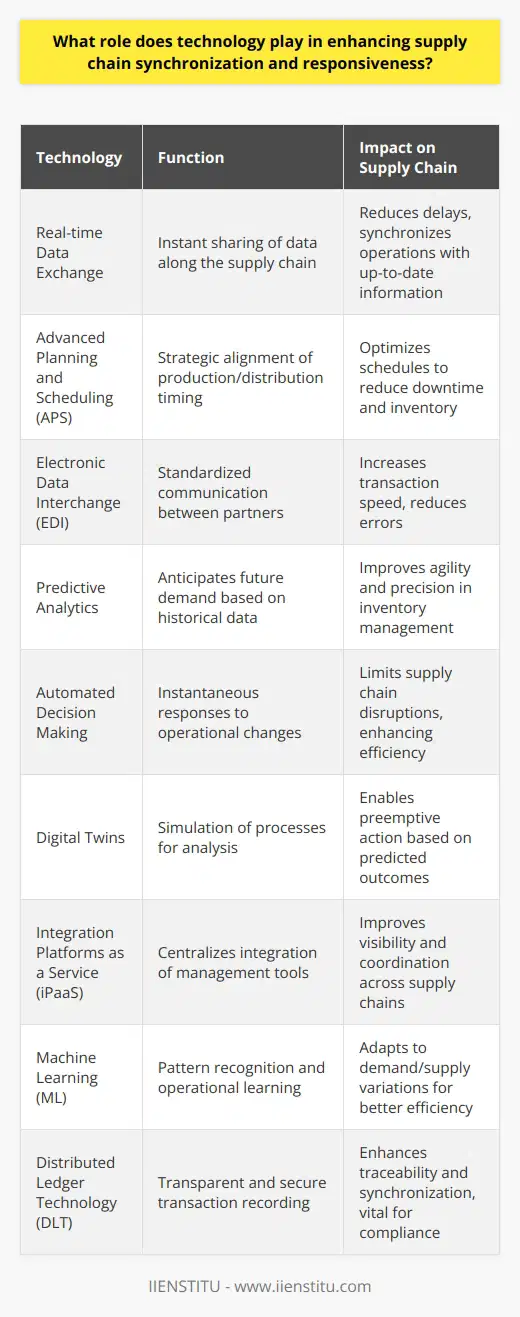
What are the three Ps of supply chain synchronization?
**Supply Chain Synchronization Overview**
The three Ps of supply chain synchronization are product, process, and partner. These elements work together within the supply chain system to encourage seamless flow, increase efficiency, and enhance collaboration among participants.
**Product Synchronization**
Product synchronization entails coordinating the accurate movement of goods throughout the supply chain. Achieving product synchronization requires accurate demand forecasting, effective inventory management strategies, timely order fulfillment, and appropriate product packaging and labeling. By synchronizing the product flow, companies can avoid stockouts, reduce excess inventory, and minimize the risk of obsolescence.
**Process Synchronization**
Process synchronization focuses on harmonizing the various activities involved in the supply chain, including procurement, production, and distribution. This aspect of synchronization involves optimizing operational processes, enhancing communication, and implementing advanced planning and scheduling tools. By synchronizing processes, supply chain participants can improve overall efficiency, increase responsiveness to changes in demand, and benefit from cost-saving opportunities.
**Partner Synchronization**
Lastly, partner synchronization involves aligning the goals, strategies, and collaborative efforts of various organizations throughout the supply chain. This includes sharing information, communicating transparently, and implementing joint initiatives to improve performance and drive innovation. Strengthening partnerships and fostering trust between supply chain participants enables organizations to achieve mutual benefits and optimize overall supply chain performance.

How do you synchronize supply and demand in a global context?
Global Coordination of Supply and Demand
To synchronize supply and demand in a global context, businesses must implement strategies that maximize efficiency and effectiveness in their production and distribution processes. The following measures can be adopted to achieve the desired state of balance:
Real-time Data Analysis
Organizations must gather, analyze, and interpret real-time data on market trends, consumer behavior, and industry factors. This ensures timely updates on demand patterns, enabling businesses to adjust their supply accordingly.
Forecasting Techniques
Companies should utilize advanced forecasting techniques, such as machine learning algorithms and predictive analytics, to anticipate fluctuations in demand. These methods help in accurate planning of production, inventory management, and resource allocation.
Agile Supply Chain Management
Implementing an agile supply chain management system allows organizations to respond quickly to changes in demand. This involves constantly monitoring and evaluating the supply chain's performance and making adjustments when necessary.
Strategic Supplier Partnerships
Building strong relationships with suppliers fosters better communication, resulting in a collaborative effort to align supply with demand. This approach also helps in mitigating risks associated with unexpected market changes.
Customization and Personalization
Offering a variety of products and customizable options can facilitate matching supply with customers' preferences, resulting in better demand satisfaction. Mass customization provides an opportunity to fulfill individual needs while maintaining economies of scale.
Inventory Management Optimization
By optimizing inventory management through Just-In-Time (JIT) systems and demand-driven planning, companies can minimize excess inventory and stockouts. Robust inventory management practices contribute to synchronizing supply with demand effectively.
Risk Diversification
Diversifying production facilities and distribution networks across geographical areas helps to manage risks associated with supply and demand imbalances. This mitigates the impact of unforeseen events on the global supply chain.
Cultural Sensitivity
Adopting strategies that consider cultural differences among various markets enables businesses to cater to local preferences, ultimately leading to better synchronization between supply and demand.
In conclusion, balancing global supply and demand requires constant adaptation, collaboration, and responsiveness to changing market conditions. By adopting the above-mentioned strategies and leveraging technology, companies can achieve a harmonious synchronization between supply and demand, improving overall business performance.
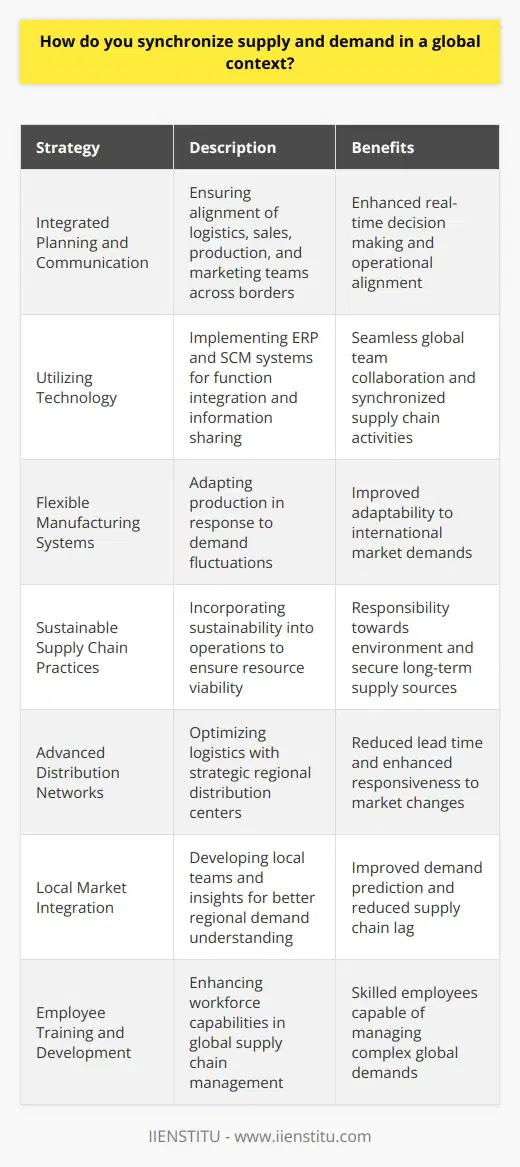
What role do information-sharing and collaboration play in achieving supply chain synchronization?
Role of Information-Sharing in Supply Chain Synchronization
Information-sharing and collaboration play crucial roles in achieving supply chain synchronization. Effective supply chain synchronization requires streamlined information exchange and real-time communication among the key partners involved. This exchange of information enables supply chain partners to make informed decisions, optimize resources, and take timely actions, thus decreasing delays and disruptions in production, delivery, or customer service.
Benefits of Collaborative Information-Sharing
Collaborative information-sharing contributes to the flexibility and responsiveness of the supply chain. By sharing specific, accurate, and timely data, partners can better predict and respond to changes in demand or unforeseen events. In this way, they can minimize potential risks and maintain stability in the supply chain.
Increased Visibility and Trust
Increased visibility and trust among supply chain partners are direct results of improved information-sharing and collaboration. Enhanced transparency enables partners to be more confident in each other's abilities to meet timelines and deliver high-quality products. In turn, trust fosters more effective cooperation in managing supply chain processes and proactively addressing potential challenges.
Improved Forecasting and Planning
Collaborative information-sharing supports supply chain synchronization by facilitating better forecasting and planning. Access to shared data about customer preferences, market trends, and anticipated demand allows each partner to accurately predict its requirements, enhance production planning, and allocate resources efficiently. This, in turn, leads to a more agile supply chain that can readily adapt to fluctuations in the market.
Operational Efficiency and Cost Reduction
Sharing information and collaborating in real-time lead to operational efficiency and cost reduction across the supply chain. By working together, partners can adopt best practices, eliminate redundancies, and streamline processes. As a result, they can achieve cost savings and enhance customer satisfaction while remaining competitive in the market.
In conclusion, information-sharing and collaboration are the cornerstones of supply chain synchronization, which can be achieved through enhanced transparency, trust, and cooperation. These foundations enable supply chain partners to optimize their operations, predict market changes, and adapt to evolving customer demands while reducing costs and mitigating potential risks.
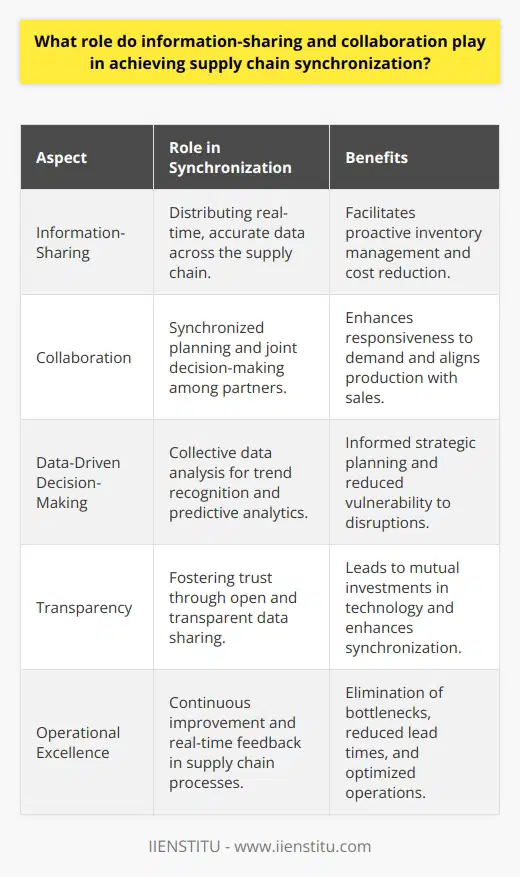
What is the impact of effective supply chain synchronization on overall business performance?
Impact of Supply Chain Synchronization
Strengthening Business Competitiveness
Effective supply chain synchronization plays a crucial role in strengthening a business's overall competitiveness. By optimizing end-to-end operations, organizations can reduce lead time, minimize inventory costs, and improve on-time delivery.
Facilitating Proactive Decision-Making
Streamlining the supply chain fosters proactive decision-making by providing stakeholders with accurate, real-time data on inventory levels and product demand, allowing them to quickly adapt to changes in market conditions.
Enhancing Customer Satisfaction
Improved supply chain synchronization ultimately translates to enhanced customer satisfaction. Delivering goods and services to customers at the right time and place is crucial for developing a loyal customer base and promoting positive brand reputation.
Reducing Operational Risks
A synchronized supply chain mitigates operational risks by promoting greater visibility, communication, and collaboration among different stakeholders. This minimizes disruptions caused by unforeseen events, such as natural disasters and global pandemics, and supports business continuity.
Promoting Innovation and Growth
By establishing a stable supply chain, businesses can devote more resources towards product and process innovation, thereby driving long-term growth. A well-synchronized supply chain encourages companies to invest in new technologies, enhance existing products, and identify potential business opportunities.
In conclusion, effective supply chain synchronization positively impacts a company's overall business performance by bolstering competitiveness, encouraging proactive decision-making, enhancing customer satisfaction, reducing operational risks, and promoting innovation and growth. Investing in supply chain synchronization provides a strong foundation for businesses to thrive in increasingly complex and demanding markets.

How can organizations identify potential bottlenecks and areas for improvement in their supply chain synchronization processes?
Identifying Potential Bottlenecks
Organizations can identify potential bottlenecks and areas for improvement in their supply chain synchronization processes through various techniques. These include mapping and analyzing their supply chain network, setting performance and efficiency benchmarks, and implementing advanced technological solutions.
Supply Chain Network Analysis
Firstly, organizations should conduct a detailed analysis of their supply chain network. This involves mapping the entire supply chain, highlighting the flow of goods, information, and financial transactions. By visualizing the entire network, organizations can quickly identify critical nodes and potential bottlenecks that could hamper supply chain efficiency.
Performance and Efficiency Benchmarks
Secondly, organizations must set performance and efficiency benchmarks for each stage of the supply chain. These benchmarks can include metrics such as lead time, order cycle time, and stockholding levels. By monitoring these metrics continuously, organizations can quickly detect variations in performance and efficiency, which indicates areas for improvement.
Advanced Technological Solutions
Thirdly, the implementation of advanced technological solutions such as digital supply chain management tools, Internet of Things (IoT) devices, and machine learning algorithms can assist organizations in improving supply chain synchronization. These solutions provide real-time visibility into the supply chain and facilitate data-driven decision-making. This allows organizations to identify potential bottlenecks and areas for improvement proactively.
Supply Chain Collaboration
Lastly, fostering collaboration among supply chain partners can significantly enhance supply chain synchronization. Organizations should engage in collaborative planning and joint problem-solving with their suppliers, customers, and logistical partners. Open communication and information-sharing enable organizations to identify potential bottlenecks and develop solutions together.
In conclusion, a thorough analysis of the supply chain network, setting performance benchmarks, and embracing advanced technological solutions can significantly improve supply chain synchronization. Organizations should also actively engage in collaboration with supply chain partners to identify potential bottlenecks and areas for improvement, ultimately enhancing overall supply chain efficiency.
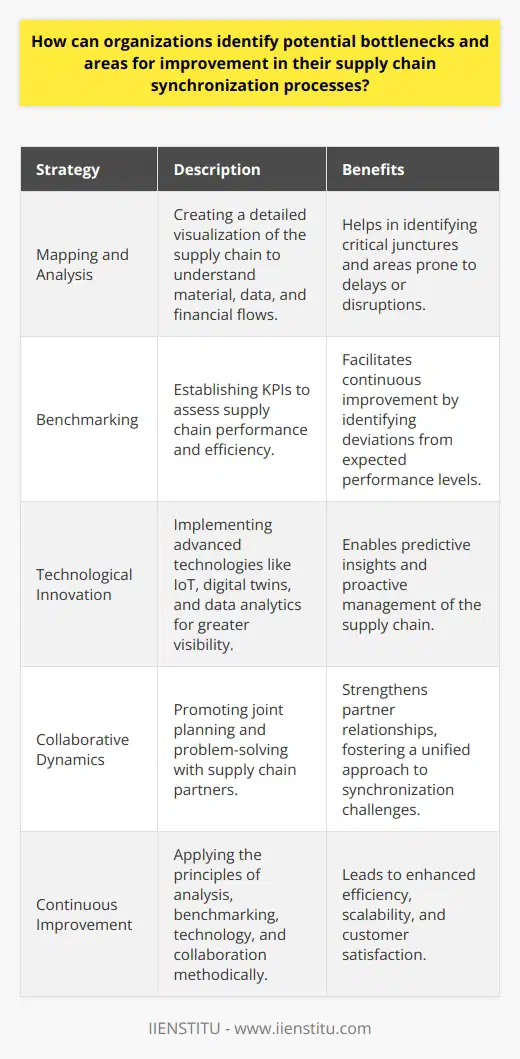
What are the main barriers to achieving supply chain synchronization and how can they be overcome?
Barriers to Supply Chain Synchronization
Several key factors impede supply chain synchronization, and addressing these barriers is crucial to achieving efficient and seamless operations. The main barriers can be categorized as communication issues, technological barriers, organizational misalignment, and demand forecast inaccuracies.
Communication Issues
The lack of effective communication between supply chain partners can lead to misunderstandings, errors, and delays. To overcome this, companies must establish robust communication channels and protocols to facilitate smooth interaction among different stakeholders. Regular meetings, cross-functional teams, and standardized information-sharing techniques can strengthen communication within the supply chain.
Technological Barriers
Implementing advanced technology is essential for effective supply chain synchronization. The absence of a proper technological infrastructure can cause a lack of visibility, slow response times, and reduced agility. Companies should invest in information-sharing technologies, such as Enterprise Resource Planning (ERP) systems and Electronic Data Interchange (EDI), and collaborate with their supply chain partners to ensure seamless integration and the ability to adapt to changing circumstances.
Organizational Misalignment
A lack of coordination among different departments within a company, as well as between supply chain partners, can undermine the synchronization process. Aligning business processes and strategies across the supply chain is vital in achieving seamless operations. This can be addressed through establishing shared objectives, developing performance metrics, and incentivizing collaboration.
Demand Forecast Inaccuracies
Inaccurate demand forecasting can result in stockouts, excess inventory, and increased costs. Firms need to develop accurate forecasting methods by leveraging historical data, utilizing sophisticated forecasting techniques, and incorporating collaborative planning and forecasting processes with supply chain partners.
Conclusion
In conclusion, overcoming the barriers to supply chain synchronization requires effective communication, technological investments, organizational alignment, and accurate demand forecasting. By addressing these challenges, companies can enhance their supply chain performance and adapt quickly to fluctuations in demand, resulting in greater efficiency and competitiveness.
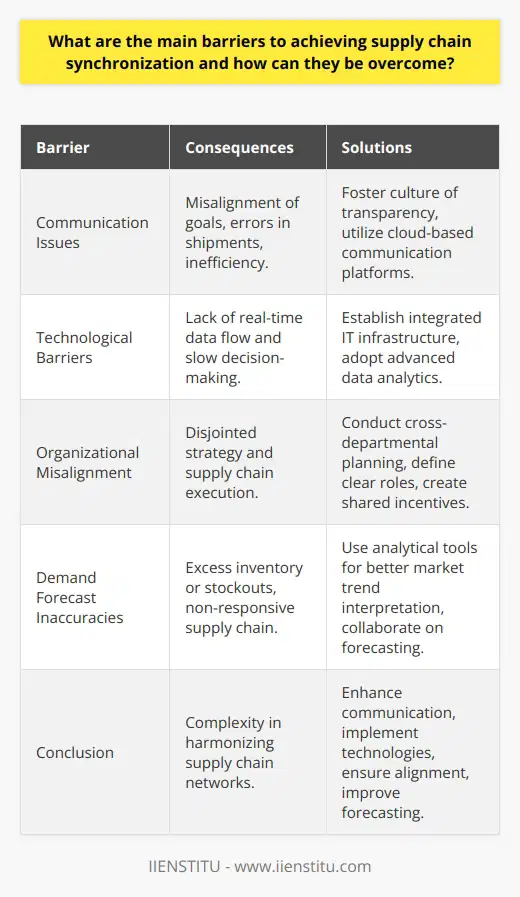
What is the purpose of synchronizing within supply chain?
Purpose of Synchronizing in Supply Chain
Effective management is vital for any successful supply chain. It all starts with synchronization. The main purpose of synchronization within supply chain is to ensure operational efficiency. This is accomplished by precisely aligning the flow of materials, information, and financial transactions.
Benefits of Synchronization
Synchronization reduces the bullwhip effect. The bullwhip effect refers to the phenomenon of increasing variability in orders as one moves up the supply chain. This variability leads to more inventory build up, increasing costs. Also, synchronization simplifies the measurement processes. It allows for accurate tracking of goods in real-time, reducing discrepancies and errors.
Importance of Timely Response
Timely response also plays a crucial role. Early detection and quick reaction to changes or unforeseen issues can minimize potential risks. Effective synchronization improves the ability to respond to customer needs and market changes in a timely manner. This responsiveness directly affects customer satisfaction.
Conclusion
In conclusion, synchronization is the key to efficiency and resilience in the supply chain. By maintaining a smoother flow across all transactions and enhancing the capacity to detect and react to changes, synchronization can lead to reduced costs, improved service levels, and overall profitability. In a globalized world, mastering the complex dynamics of supply chain synchronization becomes fundamental for companies seeking success and competitive edge.
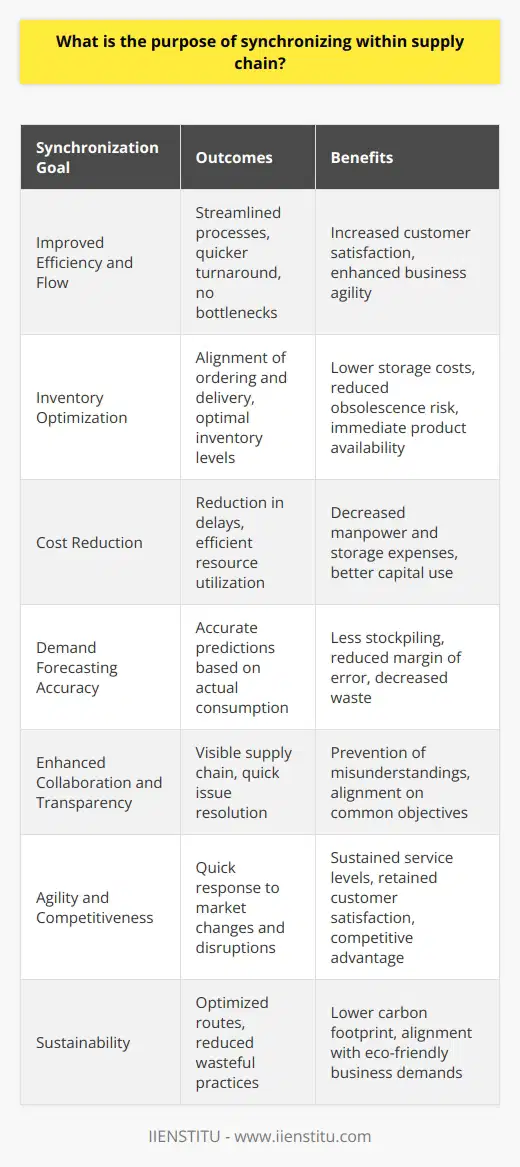
How supply chain synchronization helps an organization?
Supply Chain Synchronization Importance
Supply chain synchronization is vital for organizations. It ensures regularity and coherence in business operations. The synchronization helps in streamlining the various processes involved in supply chain management.
Increased Efficiency
One main advantage is higher efficiency. It leads to reduced delays in delivery and improved customer satisfaction. The synchronization allows quick response to changes in demand or supply. Thus, it increases overall operations efficiency.
Reduced Costs
Another benefit is cost reduction. Coordination in supply chain reduces redundant processes. It eliminates unnecessary overheads and lowers the cost of operations. Hence, it increases the profitability of the organization.
Risk Mitigation
Supply chain synchronization also helps mitigate risks. It guards against logistical errors that can disrupt operations. A synchronized supply chain makes it easier to track and manage inventory, reducing the risk of overstocking or understocking.
Improved Customer Satisfaction
Additionally, supply chain synchronization leads to improved customer satisfaction. With efficient and timely deliveries, the company can meet customer expectations. The enhanced satisfaction boosts the company's reputation, leading to increased customer loyalty.
In conclusion, supply chain synchronization offers numerous advantages to an organization. By boosting efficiency, reducing costs, mitigating risks, and improving customer satisfaction, it helps companies become more competitive and profitable. Thus, companies should aim at achieving a well-synchronized supply chain in their operations.
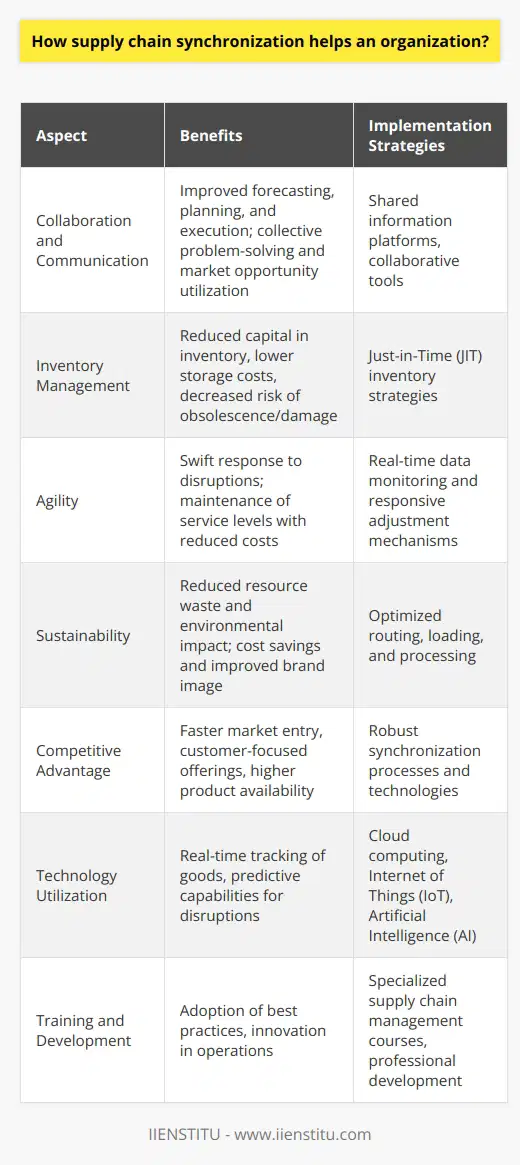
What supply chain synchronization attempts to achieve?
Synchronization Objectives
Supply chain synchronization primarily seeks to streamline and coordinate various elements within a supply chain. It emphasizes improving operational efficiency and effectiveness overall.
Enhanced Efficiency
Achieving efficiency includes minimizing costs and maximizing output at all phases. A synchronized supply chain seeks to limit waste, reduce redundancy and eliminate bottlenecks. This can involve coordinating timing of processes, synchronizing inventory with demand, and organizing space and transportation logistics.
Improved Responsiveness
Synchronization also aims to enhance responsiveness. Response time to changes in demand or unforeseen disruptions significantly influences a supply chain's success. A synchronized supply chain responds quickly to market changes or unforeseen circumstances.
Reduced Lead Times
A major focus of synchronization is reducing lead times. Shortening the time between customer orders and product availability improves efficiency, satisfies customers, and promotes competitiveness. This can also lower costs and time to market.
Balanced Inventory Levels
Inventory management is another synchronization goal. Balancing inventory levels avoids stockouts and overstocking. Optimal supply chain synchronization ensures the right amount of inventory is available at the right time.
Overall, supply chain synchronization attempts to integrate and harmonize all actions within a supply chain. It aims for a common purpose: streamlined operations, efficient processes, improved responsiveness, reduced lead times, and balanced inventory levels. The end result is a competitive advantage, improved service levels, and increased profitability.
